实验7:基于REST API的SDN北向应用实践
一、实验目的
- 能够编写程序调用OpenDaylight REST API实现特定网络功能;
- 能够编写程序调用Ryu REST API实现特定网络功能。
二、实验环境
- 下载虚拟机软件Oracle VisualBox或VMware;
- 在虚拟机中安装Ubuntu 20.04 Desktop amd64,并完整安装Mininet、OpenDaylight(Carbon版本)、Postman和Ryu;
三、实验要求
(一)基本要求
-
编写Python程序,调用OpenDaylight的北向接口实现以下功能
(1) 利用Mininet平台搭建下图所示网络拓扑,并连接OpenDaylight;拓扑结构
![]()
启动连接ODL控制器,查看图形界面
![]()
(2) 下发指令删除s1上的流表数据。
python代码
import requests from requests.auth import HTTPBasicAuth if __name__ == "__main__": url = 'http://127.0.0.1:8181/restconf/config/opendaylight-inventory:nodes/node/openflow:1/' headers = {'Content-Type': 'application/json'} res = requests.delete(url, headers=headers, auth=HTTPBasicAuth('admin', 'admin')) print (res.content)(3) 下发硬超时流表,实现拓扑内主机h1和h3网络中断20s。
python代码块
#!/usr/bin/python import requests from requests.auth import HTTPBasicAuth def http_put(url,jstr): url= url headers = {'Content-Type':'application/json'} resp = requests.put(url,jstr,headers=headers,auth=HTTPBasicAuth('admin', 'admin')) return resp if __name__ == "__main__": url='http://127.0.0.1:8181/restconf/config/opendaylight-inventory:nodes/node/openflow:1/flow-node-inventory:table/0/flow/1' with open('timeout.json') as f: jstr = f.read() resp = http_put(url,jstr) print (resp.content)json文件内容
{ "flow": [ { "id": "1", "match": { "in-port": "1", "ethernet-match": { "ethernet-type": { "type": "0x0800" } }, "ipv4-destination": "10.0.0.3/32" }, "instructions": { "instruction": [ { "order": "0", "apply-actions": { "action": [ { "order": "0", "drop-action": {} } ] } } ] }, "flow-name": "flow1", "priority": "65535", "hard-timeout": "20", "cookie": "2", "table_id": "0" } ] }![]()
(4) 获取s1上活动的流表数。
python代码
import requests from requests.auth import HTTPBasicAuth if __name__ == "__main__": url = 'http://127.0.0.1:8181/restconf/operational/opendaylight-inventory:nodes/node/openflow:1/flow-node-inventory:table/0/opendaylight-flow-table-statistics:flow-table-statistics' headers = {'Content-Type': 'application/json'} res = requests.get(url,headers=headers, auth=HTTPBasicAuth('admin', 'admin')) print (res.content)![]()
-
编写Python程序,调用Ryu的北向接口实现以下功能
(1) 实现上述OpenDaylight实验拓扑上相同的硬超时流表下发。python代码
import requests if __name__ == "__main__": url = 'http://127.0.0.1:8080/stats/flowentry/add' with open("./RYUflowtable.json") as f: jstr = f.read() headers = {'Content-Type': 'application/json'} res = requests.post(url, jstr, headers=headers) print (res.content)json文件内容
{ "dpid": 1, "cookie": 1, "cookie_mask": 1, "table_id": 0, "hard_timeout": 20, "priority": 65535, "flags": 1, "match":{ "in_port":1, }, "actions":[ ] }![]()
(2) 参考Ryu REST API的文档,基于VLAN实验的网络拓扑,编程实现相同的VLAN配置。
生成拓扑结构
![]()
topo.py
#topo.py from mininet.topo import Topo class MyTopo(Topo): def __init__(self): # initilaize topology Topo.__init__(self) self.addSwitch("s1") self.addSwitch("s2") self.addHost("h1") self.addHost("h2") self.addHost("h3") self.addHost("h4") self.addLink("s1", "h1") self.addLink("s1", "h2") self.addLink("s2", "h3") self.addLink("s2", "h4") self.addLink("s1", "s2") topos = {'mytopo': (lambda: MyTopo())}vlan.py
# vlan.py import json import requests if __name__ == "__main__": url = 'http://127.0.0.1:8080/stats/flowentry/add' headers = {'Content-Type': 'application/json'} flow1 = { "dpid": 1, "priority": 1, "match":{ "in_port": 1 }, "actions":[ { "type": "PUSH_VLAN", "ethertype": 33024 }, { "type": "SET_FIELD", "field": "vlan_vid", "value": 4096 }, { "type": "OUTPUT", "port": 3 } ] } flow2 = { "dpid": 1, "priority": 1, "match":{ "in_port": 2 }, "actions":[ { "type": "PUSH_VLAN", "ethertype": 33024 }, { "type": "SET_FIELD", "field": "vlan_vid", "value": 4097 }, { "type": "OUTPUT", "port": 3 } ] } flow3 = { "dpid": 1, "priority": 1, "match":{ "vlan_vid": 0 }, "actions":[ { "type": "POP_VLAN", "ethertype": 33024 }, { "type": "OUTPUT", "port": 1 } ] } flow4 = { "dpid": 1, "priority": 1, "match": { "vlan_vid": 1 }, "actions": [ { "type": "POP_VLAN", "ethertype": 33024 }, { "type": "OUTPUT", "port": 2 } ] } flow5 = { "dpid": 2, "priority": 1, "match": { "in_port": 1 }, "actions": [ { "type": "PUSH_VLAN", "ethertype": 33024 }, { "type": "SET_FIELD", "field": "vlan_vid", "value": 4096 }, { "type": "OUTPUT", "port": 3 } ] } flow6 = { "dpid": 2, "priority": 1, "match": { "in_port": 2 }, "actions": [ { "type": "PUSH_VLAN", "ethertype": 33024 }, { "type": "SET_FIELD", "field": "vlan_vid", "value": 4097 }, { "type": "OUTPUT", "port": 3 } ] } flow7 = { "dpid": 2, "priority": 1, "match": { "vlan_vid": 0 }, "actions": [ { "type": "POP_VLAN", "ethertype": 33024 }, { "type": "OUTPUT", "port": 1 } ] } flow8 = { "dpid": 2, "priority": 1, "match": { "vlan_vid": 1 }, "actions": [ { "type": "POP_VLAN", "ethertype": 33024 }, { "type": "OUTPUT", "port": 2 } ] } res1 = requests.post(url, json.dumps(flow1), headers=headers) res2 = requests.post(url, json.dumps(flow2), headers=headers) res3 = requests.post(url, json.dumps(flow3), headers=headers) res4 = requests.post(url, json.dumps(flow4), headers=headers) res5 = requests.post(url, json.dumps(flow5), headers=headers) res6 = requests.post(url, json.dumps(flow6), headers=headers) res7 = requests.post(url, json.dumps(flow7), headers=headers) res8 = requests.post(url, json.dumps(flow8), headers=headers)![]()
提示:拓扑生成后需连接Ryu,且Ryu应能够提供REST API服务
| VLAN_ID | Hosts |
|---|---|
| 0 | h1 h3 |
| 1 | h2 h4 |
(二)进阶要求
OpenDaylight或Ryu任选其一,编程实现查看前序VLAN实验拓扑中所有节点(含交换机、主机)的名称,以及显示每台交换机的所有流表项。
getall.py
# getall.py
import requests
import time
import re
class GetNodes:
def __init__(self, ip):
self.ip = ip
def get_switch_id(self):
url = 'http://' + self.ip + '/stats/switches'
re_switch_id = requests.get(url=url).json()
switch_id_hex = []
for i in re_switch_id:
switch_id_hex.append(hex(i))
return switch_id_hex
def getflow(self):
url = 'http://' + self.ip + '/stats/flow/%d'
switch_list = self.get_switch_id()
ret_flow = []
for switch in switch_list:
new_url = format(url % int(switch, 16))
re_switch_flow = requests.get(url=new_url).json()
ret_flow.append(re_switch_flow)
return ret_flow
def show(self):
flow_list = self.getflow()
for flow in flow_list:
for dpid in flow.keys():
dp_id = dpid
switchnum= '{1}'.format(hex(int(dp_id)), int(dp_id))
print('s'+switchnum,end = " ")
switchnum = int(switchnum)
for list_table in flow.values():
for table in list_table:
string1 = str(table)
if re.search("'dl_vlan': '(.*?)'", string1) is not None:
num = re.search("'dl_vlan': '(.*?)'", string1).group(1);
if num == '0' and switchnum == 1:
print('h1',end = " ")
if num == '1' and switchnum == 1:
print('h2',end = " ")
if num == '0' and switchnum == 2:
print('h3',end = " ")
if num == '1' and switchnum == 2:
print('h4',end = " ")
print("")
flow_list = self.getflow()
for flow in flow_list:
for dpid in flow.keys():
dp_id = dpid
print('switch_name:s{1}'.format(hex(int(dp_id)), int(dp_id)))
for list_table in flow.values():
for table in list_table:
print(table)
s1 = GetNodes("127.0.0.1:8080")
s1.show()
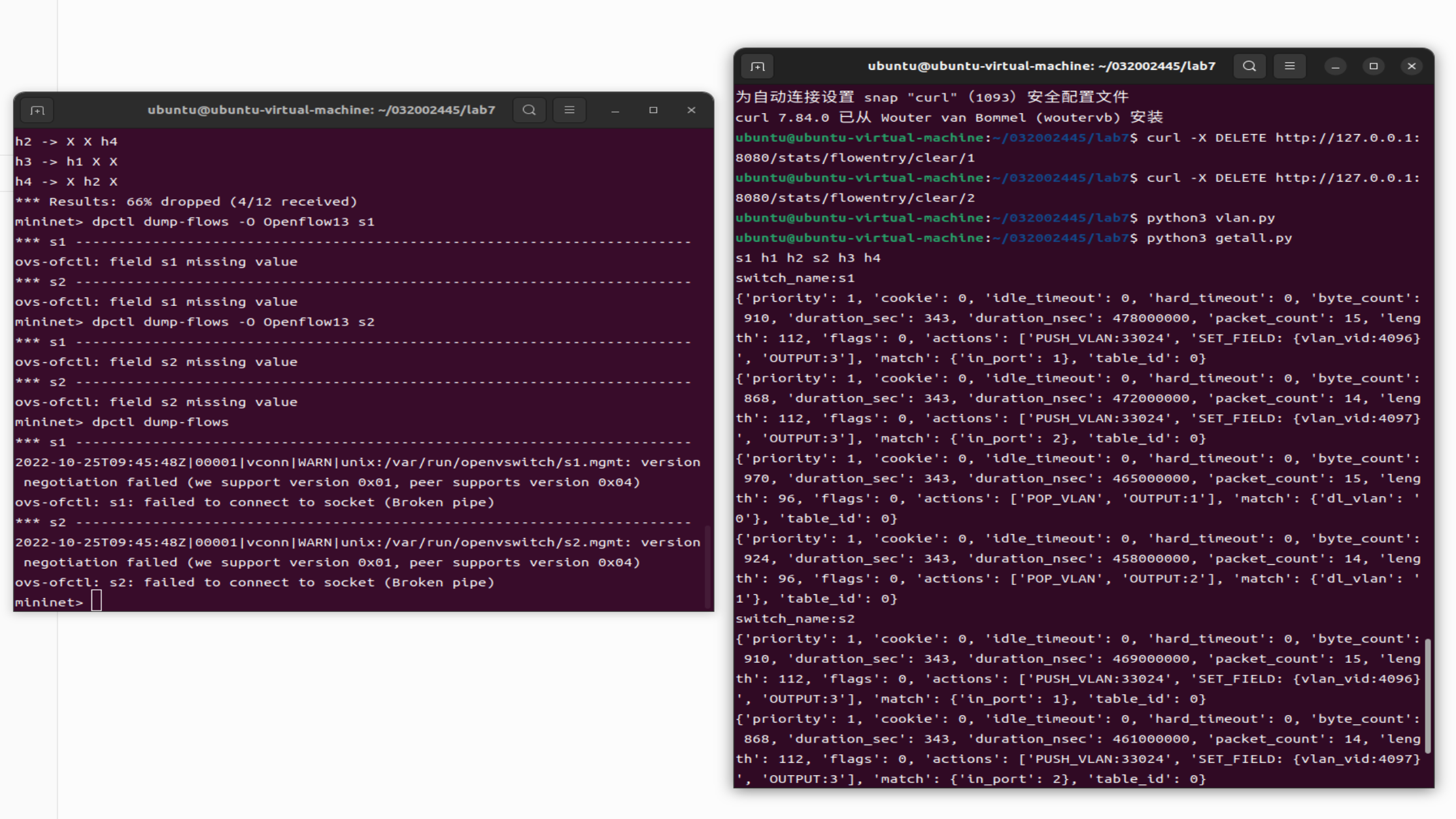
四、实验总结
通过此次实验,我对OpenDaylight和Ryu的相关知识有了更加深入的了解。此次实验还是有一定的难度,对操作(诸如通过python编程来使用ODL REST API和Ryu Rest API ),文件的理解都有一定的要求,在整个实验过程中,我也遇到了一些问题。
比如说,编写Python程序,调用Ryu的北向接口实现上述OpenDaylight实验拓扑上相同的硬超时流表下发的要求里,我始终无法运行成功书写的ryuouttime.py的文件,后来才察觉到是我一开始就没有打开ryu,导致出现低级错误,这表明我对ryu的基本操作还不是十分的熟悉。后来在阅读相关文件后,我的实验过程进行得相对顺利了许多,后面有遇到无法识别“curl”的提示,只需按照系统的提示输入“sudo apt-get install curl ”的命令就能够解决。
总之,这次实验是一个比较综合的实验,对许多操作与认知的考察都比以往的实验要上一个层次,需要更多的学习与理解。


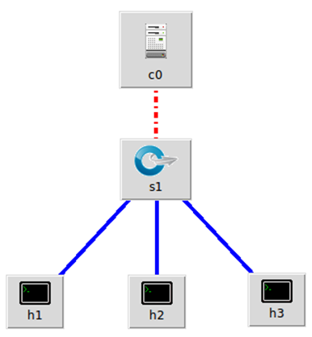
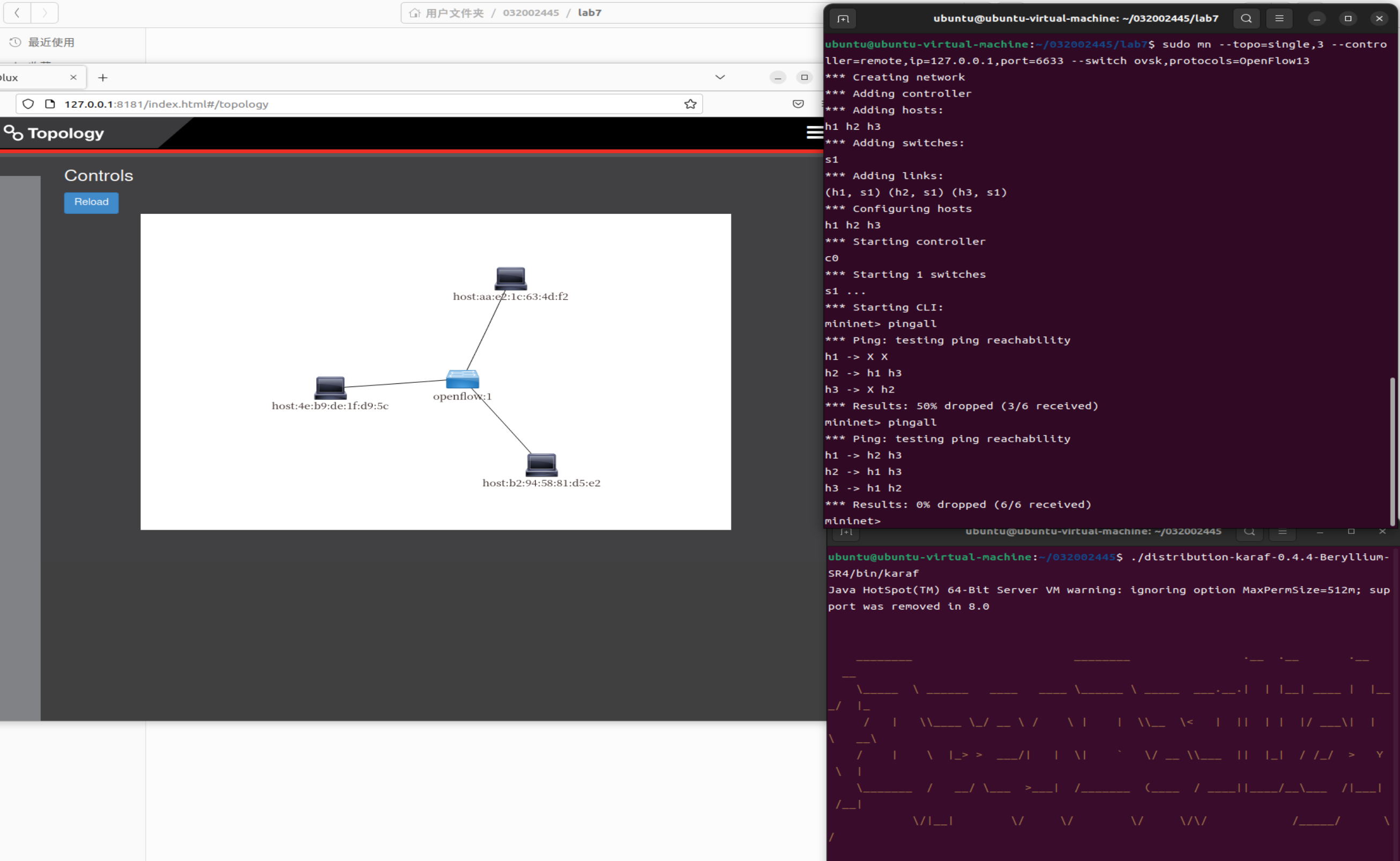



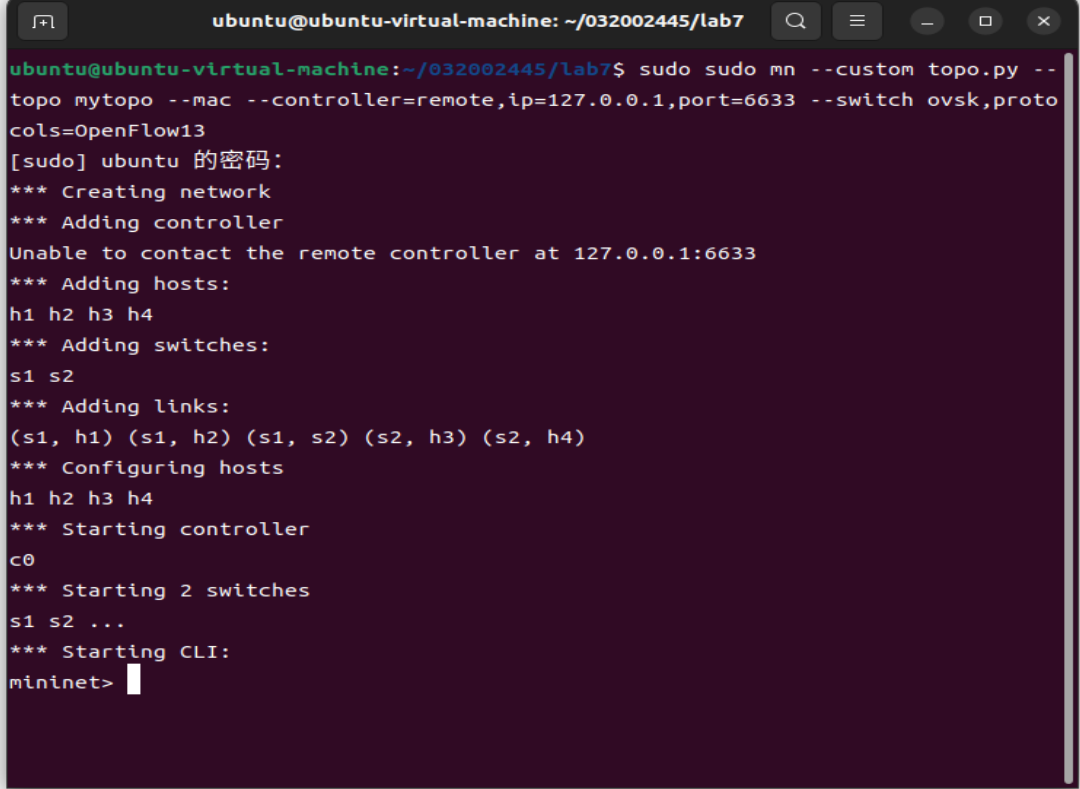
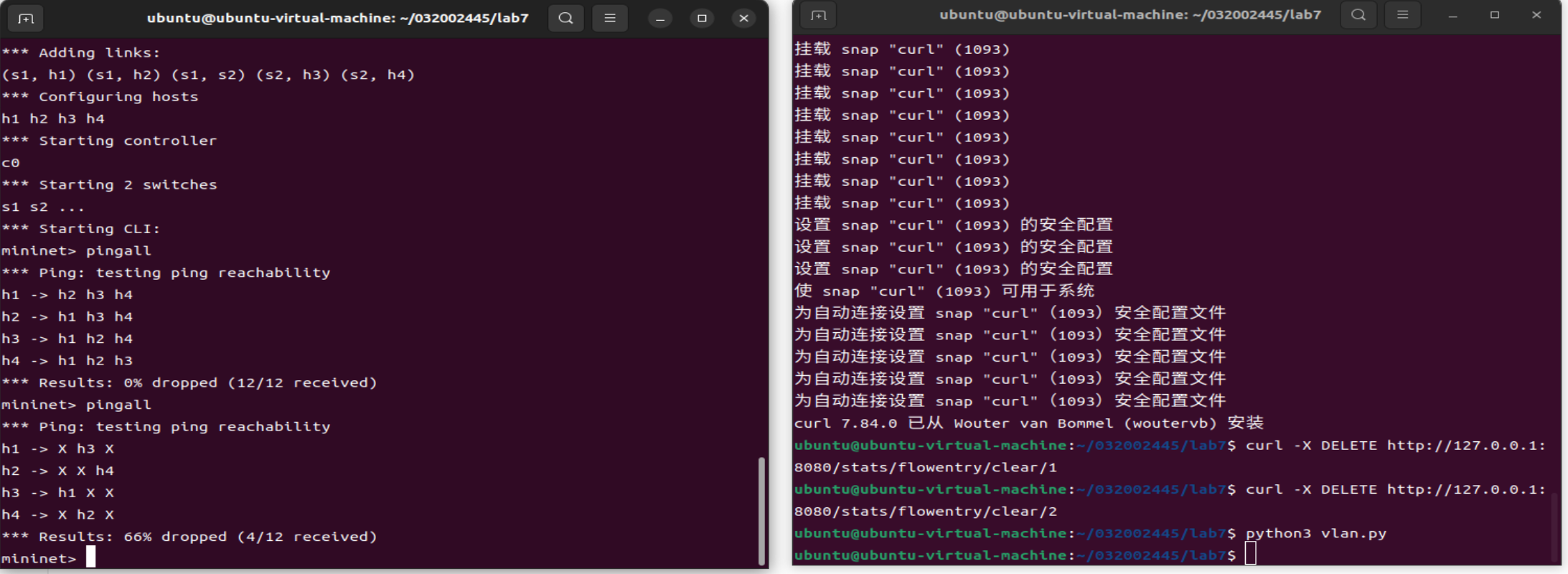

 浙公网安备 33010602011771号
浙公网安备 33010602011771号